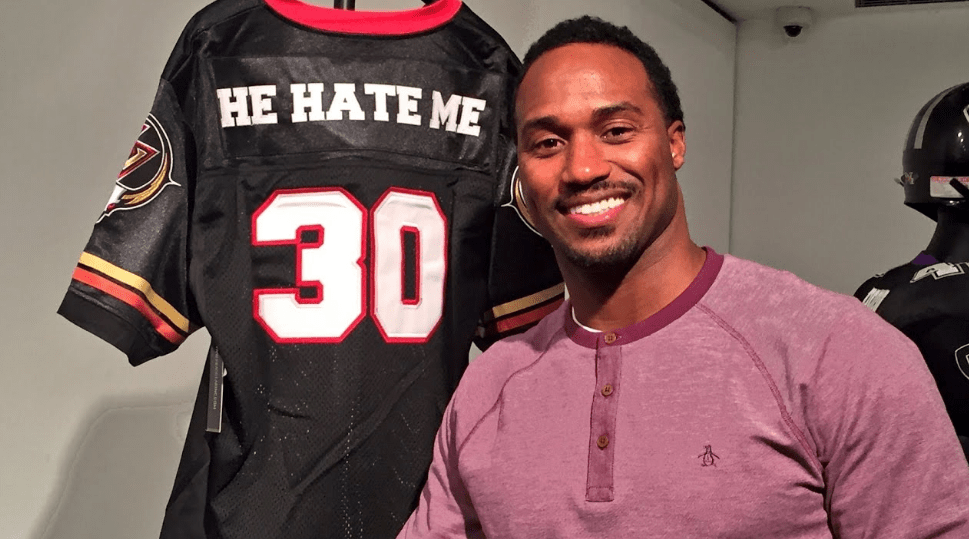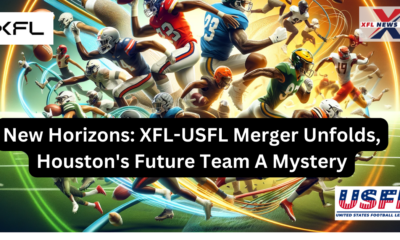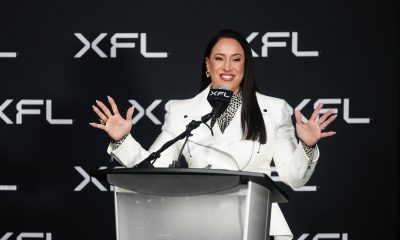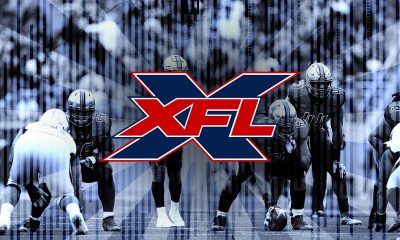
Ever since the XFL was first established in 2001, you can’t help but compare it to the NFL as the XFL was seen by many as an alternative to the NFL at the time and up to this day many still consider the XFL as an alternative to the NFL. The NFL was reportedly suffering in ratings and people wanted to see a change as they were said to be bored from what they were watching and getting from the NFL and when the XFL was introduced, people had an option as the XFL was totally different from the NFL because they were more violent, they had storylines similar to the WWE and they were promoting sex, which is what the audience and their main demographic at the time wanted to see.
When Vince McMahon created the XFL, he wanted it to really standout from the NFL and he wanted it to have it’s own name and really distance itself from the NFL. McMahon then made significant changes to the XFL to really differentiate it and to really tell it apart from the NFL.
Below are the main differences between the XFL and the NFL:
1. The opening coin toss rule of the NFL was replaced with a “scramble” where one player from each team raced to take possession of the ball.
2. During overtime, teams took turns trying to score from the opponents’ 20 yard line. One difference is that there were no first downs and the number of plays that each team made mattered. If team A scored in two plays, then team B only had that many plays to score on their next attempt. (The trade-off there was that the field goals could only be attempted on 4th down, so you couldn’t kick on first and turn it into a battle of whose kicker missed first)
3. When it came to motion at the snap, there were slightly more liberal rules for the XFL. This meant that only one player could be in motion, but he could be moving forward as long as he was outside the tackles.
4. No points were given after the touchdown kick. Instead, teams ran a play from the 2 for a point. Later they experimented with letting the team elect to run the point after play from different spots for more points.
5. Punting rules were tweaked in the XFL to create action. No fair catches (though the defenders had to observe a five yard “halo” until the ball was caught). Punts out of bounds were a penalty on the kicking team. Additionally, punts were immediately live balls. If the return team didn’t field it, the kicking team could pick it up and advance it (though there was a distance component so teams couldn’t do a punt equivalent of an onside kick)
6. For the first few weeks, they had a full bump-and-run coverage (i.e. defenders could hit the receiver anywhere on the field until the ball was in the air) but restricted it to the first five yards after a few weeks because it was killing offense.
Aside from these differences, there were also physical and cosmetic stuff. For example, all of the fields in the XFL had to be made from grass and there were no team branding on the field. Also, there were no penalties for celebrations after Touch-Downs (this was done to encourage WWE’s persona, the violence and the taunt that Vince McMahon had for the NFL as he referred to the NFL as The “No Fun League”). Finally, players in the XFL could also personalize their jersey and have nicknames at the back of their jerseys instead of their real names (the most significant and impactful one of all was Rod Smart going by the moniker “HE HATE ME”).
Rod “He Hate Me” Smart was one of the most unique and talked about players in the XFL. He was asked about his moniker “He Hate Me” and explained that the origin of his moniker came from his belief that basically, his opponent is going to hate him. “After I win, he’s gonna hate me. It is what it is. It’s a saying I was saying when I’d feel something wasn’t going my way.” said Smart. Smart continued “For example, (when) I was on the squad in Vegas and coach was putting other guys in, (if) I felt I’m better than them, you know, hey, ‘he hate me.’ See what I’m saying? Give me a chance. That’s all I ask. It came from the heart. Within. The way I felt. I feel as if everyone hates me, from my mom to my dad and even my brothers and sisters everyone Hates Me. My buddy Greg Kates always used to use it, so I took it from him.”
Aside from Rod “He Hate Me” Smart, there were other players as well in the XFL who used their nicknames at the back of their jerseys instead of their real names. These players were:
1. Haven Fields (A.K.A. Baby Boy) = Fields originally signed with the Carolina Panthers as an undrafted free agent on April 17th, 2000. Fields appeared in four pre-season games before he was released after training camp. Fields played as a Linebacker for the New York/New Jersey Hitmen in the XFL. Fields is best known for his tackles and interceptions. Fields was the youngest on the team that is why everyone referred to him as Baby Boy.
2. Jamal Duff (A.K.A. Death Blow) = Duff was drafted in the sixth round of the 1995 NFL Draft by the New York Giants. He played in all but one of New York’s 16 regular season games, starting two at defensive end and recording four sacks. After spending the 1996 season on injured reserve with a foot injury, Duff signed with the Washington Redskins, playing 26 games over two seasons (1997-98) and recording five sacks. After Duff was released, he appeared in training camp with the 2000 Oakland Raiders, but did not make the team.
The following spring, the Los Angeles Xtreme recruited him as their Defensive End. Duff became a fan favorite as one of the Xtreme’s top defensive players (recording 18 tackles and four sacks), but also for his nickname. Duff decided to name himself after an underground black comic strip character: Death Blow. The nickname was a hit with fans and probably the second-most well-known in the entire XFL, after Rod Smart’s moniker “He Hate Me”. The Xtreme won the XFL’s first (and only) title.
3. Errick Herrin (A.K.A. E-Rupt) = Herrin was a former Marine and he was well-schooled in the ways of aggressive, smash-mouth football. Herring played as a Linebacker for the Los Angeles Xtreme. Herrin played with Xtreme teammates Jonathan Himebauch and Chris Brymer at USC. His family and friends back in Akron, Ohio gave him the nickname “E-Rupt” before he left for Xtreme training camp in Las Vegas because they felt that Errick was going to re-emerge like lava from a volcano as a destructive force in pro football. Herrin lived up to his nickname as he honed that intensity as a Marine who served six months in Saudi Arabia in the Persian Gulf conflict. Herrin was reportedly within 20 miles from the debris of a patriot missile that was hit by a scud missile that landed on a US barracks and killed several US Soldiers.
4. Otis Floyd (A.K.A. Hit Squad) = Floyd first played for the Hamilton Tiger-Cats of the Canadian Football League. Floyd later won a Grey Cup Championship in 2001 with the Calgary Stampeders and then in 2006 with the BC Lions. After a productive career at Louisville, Floyd was signed as a free agent by Calgary in May of that year. Floyd became eligible for the XFL draft after being released by the Edmonton Eskimos of the CFL in late September of that year. Floyd was then selected by the San Francisco Demons in the 43rd round of the XFL draft, where he played as a Linebacker. Floyd loves to hit people first and draw first blood that is why he was called “Hit Squad.”
5. Ken Oxendine (A.K.A Ox) = Oxendine played fortThe Virginia Tech Hokies in College. His senior year, despite splitting time with Lamont Pegues, Oxendine rushed for 904 yd (827 m) and eight touchdowns. Oxendine spent his first training camp with the Detroit Lions and the New England Patriots, but was released prior to the season. Oxendine started in 9 of 12 games during the 1999 season of the Atlanta Falcons as he was filling in for the ailing Jamal Anderson.
Oxendine played in the 1999 NFC Championship Game but was inactive for Super Bowl XXXIII. Oxendine had a career best 85 yard rushing performance against the New Orleans Saints in 1999. Oxendine played running back for two seasons for the Atlanta Falcons and briefly for the Los Angeles Xtreme. Ken Oxendine actually grew up as Little Ox. Ken’s older brother, Terrell, was known as Big Ox. Terrell, who was Ken’s role model and mentor, turned down several college baseball scholarship offers to join the marines to help support his mother and grandmother. Terrell then passed on his nickname to his younger brother Ken.
All these players have impacted the world of professional football so much so that even the NFL was considering copying suit and having the nicknames of their marquee players at the back of their jerseys instead of their real names. To this day, these players are still known and their contributions are still very much appreciated. It will be interesting to see if these players will play for the XFL when it relaunches on February 8th and 9th, 2020 and if they will still have their nicknames at the back of their jerseys.
Unleash the Action: Sign up for XFL Insider and Fuel Your Passion for Football!

2 Comments
Leave a Reply
Cancel reply
Leave a Reply
This site uses Akismet to reduce spam. Learn how your comment data is processed.
XFL Kickoff
XFL News Alerts
USFL and XFL Merger: A Deep Dive into the Historic Collaboration
Latest Podcast
-


XFL Podcast
/ 12 months agoXFL-USFL Merger Insights: Houston’s Future, Draft News, Player Movement – Ep. 216
Welcome to Episode 216 of the “XFL Week In Review,” your premier destination for...
By Mark Perry







M
July 3, 2019 at 10:36 pm
The editing department needs to keep a closer eye on their releases because besides having “The” capitalized nearly every time it is used is not a good look when trying to establish a brand when fighting against a multi-trillion dollar organization.
Pingback: Top 10 Articles From XFL News Hub In 2019, XNH Year In Review – XFL GameDay